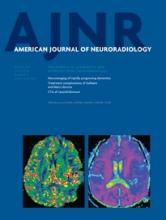Research ArticleNeurointervention
Complications of Endovascular Treatment for Acute Stroke in the SWIFT Trial with Solitaire and Merci Devices
P.T. Akins, A.P. Amar, R.S. Pakbaz and J.D. Fields on behalf of the SWIFT Investigators
American Journal of Neuroradiology March 2014, 35 (3) 524-528; DOI: https://doi.org/10.3174/ajnr.A3707
P.T. Akins
aFrom the Department of Neurosurgery (P.T.A.), Kaiser Permanente, Sacramento, California
A.P. Amar
bDepartment of Neurosurgery (A.P.A.), University of Southern California, Los Angeles, California
R.S. Pakbaz
cDepartment of Neurosurgery (R.S.P.), University of California, San Diego, San Diego, California
J.D. Fields
dDepartment of Neurology and Interventional Neuroradiology (J.D.F.), Oregon Health and Sciences University, Portland, Oregon.

REFERENCES
- 1.↵
National Institute of Neurological Disorders and Stroke rt-PA Stroke Study Group. Tissue plasminogen activator for acute ischemic stroke. N Engl J Med 1995;333:1581–87
- 2.↵
- Rha J,
- Saver JL
- 3.↵
- Tenser MS,
- Amar AP,
- Mack WJ
- 4.↵
- Del Zoppo GJ,
- Higashida RT,
- Furlan AJ,
- et al.
- 5.↵
- Furlan A,
- Higashida R,
- Wechsler L,
- et al.
- 6.↵
IMS Study Investigators. Combined intravenous and intra-arterial recanalization for acute ischemic stroke: the Interventional Management of Stroke Study. Stroke 2004;35:904–11
- 7.↵
- Smith WS,
- Sung G,
- Starkman S,
- et al.
- 8.↵
IMS II Trial Investigators. The Interventional Management of Stroke (IMS) II Study. Stroke 2007;38:2127–35
- 9.↵
- Bose A,
- Henkes H,
- Alfke K,
- et al.
- 10.↵
- Smith WS,
- Sung G,
- Saver J,
- et al.
- 11.↵
- Miteff F,
- Faulder KC,
- Goh AC,
- et al
- 12.↵
- Machi P,
- Costalat V,
- Lobotesis K,
- et al
- 13.↵
- Saver JL,
- Jahan R,
- Levy EI,
- et al.
- 14.↵
TIMI Study Group. The Thrombolysis in Myocardial Infarction (TIMI) trial: phase I findings. N Engl J Med 1984;33:523–30
- 15.↵
Cancer Therapy Evaluation Program, Common Terminology Criteria for Adverse Events, Version 3.0, DCTD, NCI, NIH, DHHS March 31, 2003. (http://ctep.cancer.gov), Publish Date: August 9, 2006.
- 16.↵
- Hacke W,
- Kaste M,
- Fieschi C,
- et al.
- 17.↵
- Shi Z-S,
- Liebeskind DS,
- Loh Y,
- et al.
- 18.↵
- Khatri P,
- Broderick JP,
- Khoury JC,
- et al.
- 19.↵
- Teal PA,
- Pessin MS
- 20.↵
- Mehra M,
- Hendricks GH,
- O'Callaghan JM,
- et al
- 21.↵
- Broderick JP,
- Palesch YY,
- Demchuk AM,
- et al.
- 22.↵
- Pausch R
In this issue
American Journal of Neuroradiology
Vol. 35, Issue 3
1 Mar 2014
Advertisement
P.T. Akins, A.P. Amar, R.S. Pakbaz, J.D. Fields
Complications of Endovascular Treatment for Acute Stroke in the SWIFT Trial with Solitaire and Merci Devices
American Journal of Neuroradiology Mar 2014, 35 (3) 524-528; DOI: 10.3174/ajnr.A3707
0 Responses
Jump to section
Related Articles
- No related articles found.
Cited By...
- Air emboli during neuroendovascular procedure treated with hyperbaric oxygen therapy
- Predictors of distal embolization during thrombectomy for anterior circulation large vessel bifurcation occlusion stroke
- Prediction of vasospasms as complication in ischemic stroke patients receiving anterior circulation endovascular stroke treatment
- Complications of Mechanical Thrombectomy in Acute Ischemic Stroke
- Preclinical testing platforms for mechanical thrombectomy in stroke: a review on phantoms, in-vivo animal, and cadaveric models
- Transradial approach for neurointerventions: a systematic review of the literature
- Coil migration during or after endovascular coiling of cerebral aneurysms
- Access-Site Complications in Mechanical Thrombectomy for Acute Ischemic Stroke: A Review of Prospective Trials
- Endovascular mechanical thrombectomy for acute stroke in young children
- The Role Of Circle Of Willis Anatomy Variations In Cardio-embolic Stroke - A Patient-specific Simulation Based Study
- Cerebral catheter angiography and its complications
- Vessel perforation during stent retriever thrombectomy for acute ischemic stroke: technical details and clinical outcomes
- Wire escalation in emergent revascularization procedures of internal carotid artery occlusions: the use of high tip stiffness microguidewires
- An in vitro evaluation of distal emboli following Lazarus Cover-assisted stent retriever thrombectomy
- Prevention of Stroke in Patients With Silent Cerebrovascular Disease: A Scientific Statement for Healthcare Professionals From the American Heart Association/American Stroke Association
- Aneurysms in the target vessels of stroke patients subjected to mechanical thrombectomy: prevalence and impact on treatment
- Solitaire FR revascularization device 4x40: safety study and effectiveness in preclinical models
- Groin complications in endovascular mechanical thrombectomy for acute ischemic stroke: a 10-year single center experience
- Stent retriever thrombectomy with the Cover accessory device versus proximal protection with a balloon guide catheter: in vitro stroke model comparison
- Mechanical Thrombectomy of Distal Occlusions in the Anterior Cerebral Artery: Recanalization Rates, Periprocedural Complications, and Clinical Outcome
- The Trevo XP 3x20 mm retriever ('Baby Trevo) for the treatment of distal intracranial occlusions
- Multicenter clinical experience in over 125 patients with the Penumbra Separator 3D for mechanical thrombectomy in acute ischemic stroke
- Determinants of Intracranial Hemorrhage Occurrence and Outcome after Neurothrombectomy Therapy: Insights from the Solitaire FR With Intention For Thrombectomy Randomized Trial
- Endovascular revascularization results in IMS III: intracranial ICA and M1 occlusions
- Reperfusion of Very Low Cerebral Blood Volume Lesion Predicts Parenchymal Hematoma After Endovascular Therapy
- Double Solitaire Mechanical Thrombectomy in Acute Stroke: Effective Rescue Strategy for Refractory Artery Occlusions?
This article has not yet been cited by articles in journals that are participating in Crossref Cited-by Linking.
More in this TOC Section
Similar Articles
Advertisement











